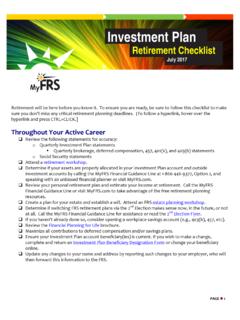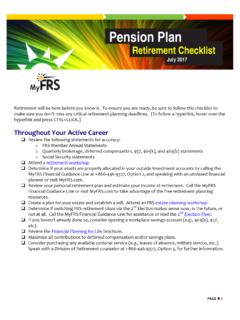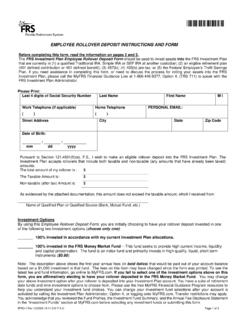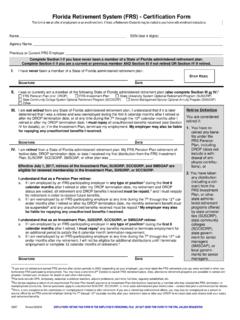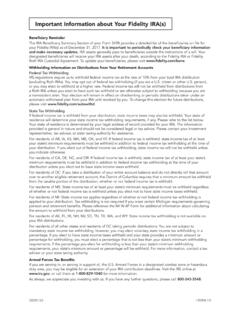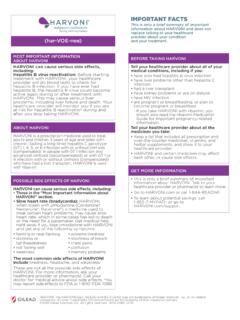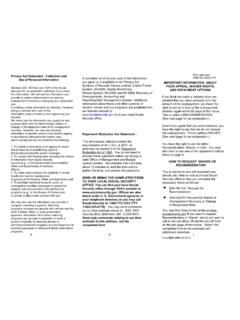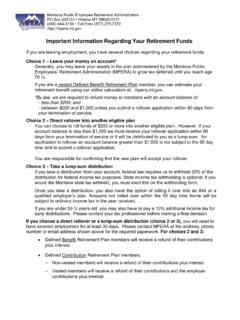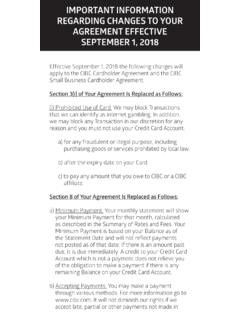Transcription of Important Information About Your Investment Funds, Fees ...
1 Last updated 07/01/2020 For more Information on Investment funds offered through the Investment Plan, please visit 1 What s Inside? 1. About Fees and Expenses 2. The Plan s Investment Funds 3. Investment -Related Information 4. Terms You Should Know 5. Fund Fact Sheets Important Information About your Investment Funds, Fees, and Other Expenses for the FRS Investment Plan Annual Fee Disclosure Statement The Florida Retirement System (FRS) Investment Plan is a great way to build savings for your future. Through the Investment Plan you get: Contributions from your employer. Contributions from you through your 3% employee pre-tax contributions. A diversified Investment line-up that is monitored by the State Board of Administration (SBA).
2 You ll want to choose investments in the plan that will meet your long-term retirement needs. Tools are available at and by calling the MyFRS Financial Guidance Line toll-free at 1-866-446-9377, Option 2 (TRS 711). Explore how your investing decisions impact your long-term retirement planning goals. See the Investment Plan Summary Plan Description on to learn more. Review this notice to learn more About fees and expenses, the Investment funds, and where to go for more Information or to take action. 1. About Fees and Expenses As with other investments, some fees and expenses in the Investment Plan are paid by Investment Plan members. There are several types of fees: Some fees are asset-based fees, which are expressed as a percentage of holdings in an Investment .
3 For FRS Investment options, asset-based fees primarily cover Investment management services and certain fund operating expenses. In the Investment Plan, you won t see these fees directly because they are charged to the Investment funds and reduce your Investment earnings. The asset-based fees charged to the Investment funds (also called the fund expense ratio ) are shown in Section 3 of this notice. You may also have direct fees that are a separate fee being charged to your account, or to you individually, and may be due to activity you have requested (see the sidebar below to learn About administrative fees). When you decide to invest in any of the primary funds in the Investment Plan there are no upfront sales loads or charges.
4 None of the non-mutual or mutual funds in the Investment Plan pay fees to vendors serving the Investment Plan, including the Investment Plan Administrator, Education Provider, and Custodian. However, the expense ratio of some mutual funds includes 12b-1 fees, which may pay for fund sales and marketing services. In those cases, the mutual fund credits the 12b-1 fees directly to the Investment Plan, and the Investment Plan in turn distributes those credits to plan members accounts through the fund s daily per share market value (known as the fund's daily net asset value, or NAV, pricing). Fees and expenses are Important because they can substantially reduce the growth of your account over the long term.
5 (You can find an example that illustrates this concept on the Department of Labor s website - However, fees are only one of several factors to consider when making Investment decisions. You should carefully consider other key factors, including asset class and Investment risk, Investment objectives, principal Investment strategies, and historical performance when selecting Investment funds. Administrative Fees Charged Directly to Members Administrative Fees: Inactive members (not actively working for 3 calendar months) are charged $6 per quarter to cover costs associated with operational expenses such as trustee and recordkeeping fees. If applicable to you, these fees are charged directly to your Investment Plan account and will be reflected on your quarterly account statement.)
6 Self-Directed Brokerage Account (SDBA) Maintenance Fee: If you established an SDBA and transferred funds to the account, you may be charged, depending upon the investments purchased and sold within the SDBA, other commissions and fees. (See page 2 for more Information .) Last updated 07/01/2020 For more Information on Investment funds offered through the Investment Plan, please visit 2 2. The Plan s Investment Funds As a member of the Investment Plan, you re responsible for investing your account in one or any combination of the Plan s Investment funds. An SDBA is also available in which you can invest in thousands of different investments in addition to the Investment Plan s primary Investment funds (see the section Self-Directed Brokerage Account below for more Information ).
7 Section 3 provides specific Information About the following Investment funds: Retirement Date Funds are particularly good for one-stop shopping . Each Retirement Date Fund is a diversified portfolio of other Investment Plan funds and uses an asset allocation concept called target date investing. The mix of funds in each Retirement Date Fund is based on your date of birth and the amount of time you have before retirement. The mix of funds gradually changes as you approach retirement. This gradual change follows a careful Investment strategy called a glide path. Each Retirement Date Fund s glide path was developed for the FRS by a global Investment consulting firm and a fiduciary to the FRS.
8 Money Market Funds invest in short-term securities (financial instruments or obligations) that are high quality and can be sold quickly with little loss of value. The funds have limited risk of declining in value. However, over the long-term, the returns may be modest and returns may not keep pace with inflation. Money market funds are not FDIC insured or guaranteed. Inflation Protection Funds invest in a diversified mix of assets that may help offset inflationary pressures. The funds seek long-term real (net of inflation) returns to preserve the future purchasing power of accumulated assets. You could lose money over short or long periods by investing in this fund, and returns may not keep pace with inflation.
9 The fund s price and return will vary over a wide range. Bond Funds invest primarily in bonds, which are similar to IOUs. A company or government agency borrows money and pays it back with interest to the bondholder (the person making the loan). When inflation or interest rates go up, the value of a bond goes down because bonds pay a fixed rate of interest. Stock Funds invest primarily in stocks issued by companies. The short-term risk of investing in stocks has been much higher than bonds. However, over long periods of time, stocks have generally done better than bonds, which is one of the main reasons that stocks are typically recommended for retirement investing.
10 Some risk is necessary to achieve long-term Investment growth. Foreign/Global Stock Funds invest primarily in stocks issued by foreign companies. Compared to stocks, foreign stocks are affected by additional risk factors such as foreign laws and regulations, differences in accounting practices, political risk (foreign governments are sometimes unstable), and currency risks (differences in the relative value of domestic and foreign money). Over the long-term, foreign stocks have provided additional diversification benefits. Default Investment Fund As an Investment Plan member, you have the right to decide how to invest your account assets. If you do not provide instructions on how to allocate your funds, your assets will be 100% invested in and continue to be invested in the Plan s default Investment fund option; an age-appropriate Retirement Date Fund.

